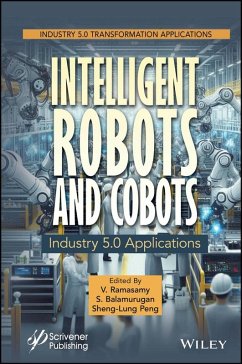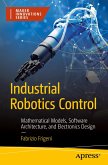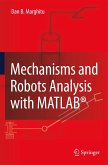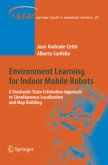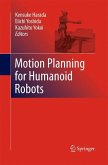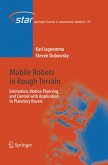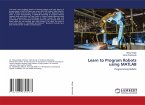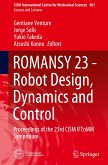Intelligent Robots and Cobots
Industry 5.0 Applications
Herausgeber: Balamurugan, S.; Ramasamy, V.; Peng, Sheng-Lung
Intelligent Robots and Cobots
Industry 5.0 Applications
Herausgeber: Balamurugan, S.; Ramasamy, V.; Peng, Sheng-Lung
- Gebundenes Buch
- Merkliste
- Auf die Merkliste
- Bewerten Bewerten
- Teilen
- Produkt teilen
- Produkterinnerung
- Produkterinnerung
Intelligent Robots and Cobots: Industry 5.0 Applicationsexplores the innovations of science and technology, specifically the transformation of Industry 5.0. With advancements in science and technology, industries are utilizing automation and other contemporary technology to simplify tasks to meet needs. This book will facilitate new paradigms in infrastructure advancements that will leverage the industry sector. The book is organized into 19 chapters that reflect current market trends, prevalent in the industry growth. Each chapter examines trends or companies that built hardware using…mehr
Andere Kunden interessierten sich auch für
![Industrial Robotics Control Industrial Robotics Control]() Fabrizio FrigeniIndustrial Robotics Control33,99 €
Fabrizio FrigeniIndustrial Robotics Control33,99 €![Mechanisms and Robots Analysis with Matlab(r) Mechanisms and Robots Analysis with Matlab(r)]() Dan B. MarghituMechanisms and Robots Analysis with Matlab(r)70,99 €
Dan B. MarghituMechanisms and Robots Analysis with Matlab(r)70,99 €![Environment Learning for Indoor Mobile Robots Environment Learning for Indoor Mobile Robots]() Juan Andrade CettoEnvironment Learning for Indoor Mobile Robots77,99 €
Juan Andrade CettoEnvironment Learning for Indoor Mobile Robots77,99 €![Motion Planning for Humanoid Robots Motion Planning for Humanoid Robots]() Motion Planning for Humanoid Robots116,99 €
Motion Planning for Humanoid Robots116,99 €![Mobile Robots in Rough Terrain Mobile Robots in Rough Terrain]() Karl IagnemmaMobile Robots in Rough Terrain81,99 €
Karl IagnemmaMobile Robots in Rough Terrain81,99 €![Learn to Program Robots using MATLAB Learn to Program Robots using MATLAB]() Abhay WaghLearn to Program Robots using MATLAB38,99 €
Abhay WaghLearn to Program Robots using MATLAB38,99 €![ROMANSY 23 - Robot Design, Dynamics and Control ROMANSY 23 - Robot Design, Dynamics and Control]() ROMANSY 23 - Robot Design, Dynamics and Control194,99 €
ROMANSY 23 - Robot Design, Dynamics and Control194,99 €-
-
Intelligent Robots and Cobots: Industry 5.0 Applicationsexplores the innovations of science and technology, specifically the transformation of Industry 5.0. With advancements in science and technology, industries are utilizing automation and other contemporary technology to simplify tasks to meet needs. This book will facilitate new paradigms in infrastructure advancements that will leverage the industry sector. The book is organized into 19 chapters that reflect current market trends, prevalent in the industry growth. Each chapter examines trends or companies that built hardware using software like AI, cognitive computing, and blockchain, IIoT. In each section, the book demonstrates how businesses utilize these developments to their advantage and stay one step ahead of the competition. In addition, recent case studies are included that show the successful use of collaborative robotics in various industries. Finally, recommendations for preparing workers for future work by reskilling and upskilling them are presented.
Hinweis: Dieser Artikel kann nur an eine deutsche Lieferadresse ausgeliefert werden.
Hinweis: Dieser Artikel kann nur an eine deutsche Lieferadresse ausgeliefert werden.
Produktdetails
- Produktdetails
- Verlag: John Wiley & Sons Inc
- Seitenzahl: 448
- Erscheinungstermin: 20. Dezember 2024
- Englisch
- ISBN-13: 9781394198177
- ISBN-10: 1394198175
- Artikelnr.: 68444212
- Herstellerkennzeichnung
- Libri GmbH
- Europaallee 1
- 36244 Bad Hersfeld
- gpsr@libri.de
- Verlag: John Wiley & Sons Inc
- Seitenzahl: 448
- Erscheinungstermin: 20. Dezember 2024
- Englisch
- ISBN-13: 9781394198177
- ISBN-10: 1394198175
- Artikelnr.: 68444212
- Herstellerkennzeichnung
- Libri GmbH
- Europaallee 1
- 36244 Bad Hersfeld
- gpsr@libri.de
V. Ramasamy, Ph.D., is an associate professor in the Department of CSE at Vel Tech Rangarajan Dr. Sagunthala R&D Institute of Science and Technology (Deemed to be University), Chennai, Tamilnadu, India. His areas of interest include mobile cloud computing, IoT, data science, artificial intelligence, and data mining. He is the author of several scholarly research papers in national and international journals and conferences. S. Balamurugan, Ph.D., is the Director of Research and Development, Intelligent Research Consultancy Services (iRCS), Coimbatore, Tamilnadu, India. He is also the Director of the Albert Einstein Engineering and Research Labs (AEER Labs), and Vice-Chairman, Renewable Energy Society of India (RESI), India. He has published 45 books, 200+ international journals/ conferences, and 35 patents. Sheng-Lung Peng, Ph.D., is a professor in the Department of Creative Technologies and Product Design, National Taipei University of Business, Taiwan. He is an honorary professor of Beijing Information Science and Technology, University of China, and a supervisor of the Chinese Information Literacy Association and the Association of Algorithms and Computation Theory. He has published more than 120 international journal and conference papers.
Preface xxi
Acknowledgement xxvii
Part 1: Fundamentals 1
1 Cobots for Industry 5.0 Transformation 3
Ahmed F. Siddiqui, Aditya J. Paul, Sushruta Mishra and S. Balamurugan
1.1 Introduction 4
1.2 Related Works 5
1.3 IoT for Industries 7
1.4 Issues with Cobots in Industry 5.0 8
1.5 Cobots in Industries 9
1.6 Automation and Cobots 11
1.7 Conclusion 13
References 14
2 Cobots as an Enabling Technique for Industry 5.0: A Conceptual Framework
19
Swati Lipsa and Ranjan Kumar Dash
2.1 Introduction 20
2.2 Industry 5.0 at a Glance 21
2.3 Industry 4.0 vs. Industry 5.0 23
2.4 Key Differences Between Robots and Cobots 25
2.5 Cobots as an Enabling Technique for Industry 5.0 26
2.6 The Contribution of Cobots Across Different Sectors 28
2.6.10 Food Processing 31
2.7 A Conceptual Cobot-Based Cyber-Physical System 32
2.8 The Risk and Security Issues with Respect to Cobots and Their
Mitigations 37
2.9 Conclusion 39
References 40
3 Role of Cobots and Industrial Robots in Industry 5.0 43
M. Makeshkumar, M. Sasi Kumar, J. Anburaj, S. Ramesh Babu, E. Vembarasan
and R. Sanjiv
3.1 Introduction 44
3.2 Role of Cobots 45
3.3 Programming Flowchart 46
3.4 Objectives of Research in Cobots 47
3.5 Capabilities and Features of Cobots for Industrial Applications 48
3.6 Industrial Developments and Different Degrees of Collaboration by
Cobots 50
3.7 Cobot Applications 51
3.8 Challenges Faced by Cobots 54
3.9 Economic Impact of Cobots 55
3.10 Components Required 56
3.11 Integration of Cobots with Other Technologies 58
3.12 Discussion 59
3.13 Future Scope 60
3.14 Conclusion 60
References 61
4 The Evolution of Cobots in Intelligent Transportation Systems 65
Rahul Jethwa, Rohit Raj Pradhan, Sushruta Mishra and S. Balamurugan
4.1 Introduction 66
4.2 Uncovering Challenges in Intelligent Transportation System 68
4.3 The Role and Application of Cobots in Manufacturing and Logistics 69
4.4 Advancing Technologies Facilitating Robot and Cobot Operations in
Intelligent Transportation Systems 71
4.5 Redefining Smart Transportation: The Synergy of Robotics, Cobots, and
Predictive Analytics in ITS 72
4.6 A Comparative Analysis of Cobot and Predictive Protocols in Enhancing
Safety and Sustainability in ITS 77
4.7 Advanced Analytics and Insights in Intelligent Transportation Systems
80
4.8 Conclusion 82
References 83
5 Low/No-Code Software Development of Cobots Using Advanced Graphical User
Interface 85
N. L. Padma Swati, S. Vanshita Gupta, Vallidevi Krishnamurthy, Sujithra @
Kanmani and Surendiran Balasubramanian
5.1 Introduction 86
5.2 Cobots 89
5.3 Design of Low/No-Code-Based Cobot Development 90
5.4 Graphical User Interface Features 94
5.5 RPA vs. Low Code No Code in Cobot Development: "Low Code or RPA? Who
Wins?" 97
5.6 Conclusion 102
5.7 Pros and Cons 102
References 105
6 Future Workforce for Industry 5.0 107
Huzina Saheal and Sheikh Sajid Mohammad
6.1 Introduction 108
6.2 Underlying Principles of Industry 5.0 109
6.3 Benefits for Workers in Industry 5.0 111
6.4 Challenges for Workers in Industry 5.0 113
6.5 Industry 5.0 and Employee Skills 114
6.6 Issues Related to Integration of Robots into Organizations 117
6.7 Considerations for Integration of Humans and Smart Machines in Industry
5.0 121
6.8 Reskilling and Upskilling the Workforce for Industry 5.0 123
6.9 Conclusion 125
References 126
Part 2: Applications 131
7 Intelligent Robots and Cobots: Concepts and Applications for Industry 5.0
Transformation 133
G. Ganesh Kumar and S. Kanakaprabha
7.1 Introduction 134
7.2 Systematic Review 138
7.3 Concepts of Intelligent Robots and Cobots 142
7.4 Benefits of Intelligent Robots and Cobots 145
7.5 Application Areas 147
7.6 Challenges and Considerations 150
7.7 Future Prospects and Impacts 152
7.8 Conclusion 154
References 155
8 Artificial Intelligence-Driven Cobots for Innovative Industry 5.0
Workforce 159
S. K. Manju Bargavi, K. R. Tejashvar and K.R. Tejashwini
8.1 Introduction 160
8.2 Literature Review 162
8.3 Revolution of Industry 5.0 163
8.4 Robotic Collaboration 166
8.5 Technological Issues with AI in the Cobot Age of Industry 5.0 169
8.6 Conclusion 173
References 174
9 Cobot Collaboration in the Healthcare Industry 177
V. Gopala Krishnan, R. Jayamurugan, P. Sakthivel and M. Gowtham
9.1 Introduction 178
9.2 Cobots and Their Role 178
9.3 Impact of Cobot 179
9.4 The Challenges of Deploying Cobots at Scale 180
9.5 Cobot Background 180
9.6 Benefits of Cobots 181
9.7 The Need for Cobot Regulation Frameworks 184
9.8 The Hardware Sector will be Led by Robotic Arms and Sensors 185
9.9 Testing in Laboratories and Care for Patients Have a Lot of
Possibilities 185
9.10 APAC Significant Gains 186
9.11 Human Factors and Errors 186
9.12 Robots Lending a Hand During the COVID-19 Outbreak 187
9.13 Universal Robots Cobots in Healthcare 187
9.14 What Role Can Cobots Play in Enhancing Healthcare Brand Experiences?
189
9.15 The Rise of the Health Companion 191
9.16 Cobots are Revolutionizing the Field of Medicine 194
9.17 Manufacturing of Medical Devices 196
9.18 Applications Outside of Healthcare 196
9.19 Next Steps of Cobot 197
9.20 Conclusion 198
References 199
10 Robotic Arm for Industry Automation 203
Sanjeev Vyaas S., Shamsudeen Babu G., Raghulnath S. S., Manikandan P. and
Joel E.
10.1 Introduction 203
10.2 Robotic Arm and Their Role in Industry 204
10.3 Desof Robotic Arm 206
10.4 Construction of Robotic Arm 207
10.5 Mechanism of a Robotic Arm 209
10.6 Working of Robotic Arm 213
10.7 How Robotic Arm are Automated 214
10.8 Industrial Automated Robotic Arm Application 216
10.9 Future Scope 217
10.10 Conclusion 218
References 218
11 Cloud-Based Cobots for Industry 5.0: A Human-Centric Solution 221
Arvind Kumar and Richa Vijay
11.1 Introduction 222
11.2 Web 5.0 224
11.3 Applications and Benefits of Industry 5.0 225
11.4 Industry 5.0 Poses the Following Opportunities and Challenges 227
11.5 What Does Industry 5.0 Mean for your Strategy? 232
11.7 A Cloud-Based Cobot System Typically Consists of Several Key
Components 235
11.8 Robot Collaboration Rather Than Competition 236
11.9 Web 5.0-Enabled Technologies and Cloud-Connected Robots 237
11.10 Security and Data Privacy Concerns in Cloud-Based Cobot Systems 238
11.11 6G Mobile Telecommunications 240
11.12 Case Studies of Successful Implementation of Cloud-Based Cobots in
Industry 5.0 241
11.13 Challenges and Future Considerations for the Integration of
Cloud-Based Cobots in Industry 5.0 242
11.14 Conclusion 243
References 244
12 Aviation Bots for Decongesting Airports 247
Saptarshi Paul
Abbreviations 248
12.1 Introduction 248
12.2 Aviation Resources 250
12.3 Understanding Real-Time Results 251
12.4 Resource Sharing and Sourcing 251
12.5 Current Aviation Bots and Their Limitations 252
12.6 Future Bots in Aviation 263
12.7 Conclusion 263
References 264
Part 3: Challenges 267
13 Cobot-Aided System for Hydroponically Grown Plants 269
Oliver Joel G., B. Jafrin Rosary, Vallidevi Krishnamurthy, Sujithra @
Kanmani and Surendiran Balasubramanian
13.1 Introduction 270
13.2 Hydroponic System 271
13.3 Cobot 273
13.4 Cobot-Aided Hydroponic System 275
13.5 iPONICS: IoT-Based Monitoring and Control System for Hydroponics
Greenhouses 276
13.6 Existing Literature 276
13.7 IoT-Cobot Integrated System Architecture 283
13.8 Results 287
13.9 Conclusion 289
References 289
14 Data Analytics and Collaborative Robots in Smart Territory: Research
Methodology, Applications, and Open Challenges 291
Bipradeep Biswas, Sushruta Mishra and S. Balamurugan
14.1 Introduction 292
14.2 Advancements in Data Analytics for Collaborative Robots 293
14.3 Challenges in Analysis of the Sensory Data 295
14.4 Research Gaps in Cobot-Enabled Data Analytics 297
14.5 Research Methodology in Cobot-Driven Data Analytics 299
14.6 Deployment of Tools and Techniques in Context-Aware Cobots 300
14.7 Provisions of Smart Architecture for Data Analytics in Collaborative
Robots 304
14.8 Advanced Sensory-Based Framework for Big Data Analytics 305
14.9 Taxonomical Categorization of Collaborative Cobots 306
14.10 Use Cases of Cobots and Data Analytics 308
14.11 Futuristic Opportunities in Data Analytics for Collaborative Robots
310
14.12 Conclusion 314
References 315
15 Comprehensive Analysis on Design, Working, and Manufacturing of Soft
Robots 317
Mithun N. S., Saravanagowri S. P., Sashankh V. R., Rithish Hari G., Nithish
Kumar S., Saravanan B. K. and Ramesh Babu S.
15.1 Introduction 318
15.2 Design of Soft Robots 319
15.3 Working and Control of Soft Robots 321
15.4 Composite Soft Robots 323
15.5 Graphene Oxide Soft Robots 325
15.6 Application in Minimally Invasive Surgery 326
15.7 Challenges of Soft Robots 328
15.8 Future Scope and Development 329
15.9 Conclusion 332
References 333
16 Investigation on Deployment of Microservices for Swarm Intelligence of
Collaborative Robots 337
Abhijit Bora, Jonti Deori and Uzzal Sharma
16.1 Introduction 338
16.2 Related Work 340
16.3 Objective and Focus of the Work 342
16.4 Experimental Arrangement 344
16.5 Reliability Assessment 350
16.6 Overall Discussion 351
16.7 Conclusion 352
References 352
17 Security Issues and Trends of Industrial Robots and Cobots 355
Samikshya Sarangi, Aswani Kumar Cherukuri, S. Chandramouliswaran, Annapurna
Jonnalgadda and Firuz Kamalov
17.1 Introduction 356
17.2 Cobots and Industrial Bots 357
17.3 Security of Cobots and Other Bots 363
17.4 Mitigation Strategies 370
17.5 Conclusions 374
References 374
18 Blockchain Technology for the Cobot's Cybersecurity Issues 377
B. Manikandan, G. Ganesh Kumar, S. Kanakaprabha, R. Vijaya Kumar Reddy and
R. Janani
18.1 Introduction 378
18.2 Literature Review 380
18.3 Introduction to Cybersecurity 382
18.4 Cybersecurity Challenges 383
18.5 Introduction to Blockchain Technology 389
18.6 Security Features of Blockchain in Cobot's Cybersecurity 390
18.7 Application Areas 393
18.8 Challenges and Considerations Cobot's Cybersecurity 395
18.9 Conclusion 397
References 398
Index 401
Acknowledgement xxvii
Part 1: Fundamentals 1
1 Cobots for Industry 5.0 Transformation 3
Ahmed F. Siddiqui, Aditya J. Paul, Sushruta Mishra and S. Balamurugan
1.1 Introduction 4
1.2 Related Works 5
1.3 IoT for Industries 7
1.4 Issues with Cobots in Industry 5.0 8
1.5 Cobots in Industries 9
1.6 Automation and Cobots 11
1.7 Conclusion 13
References 14
2 Cobots as an Enabling Technique for Industry 5.0: A Conceptual Framework
19
Swati Lipsa and Ranjan Kumar Dash
2.1 Introduction 20
2.2 Industry 5.0 at a Glance 21
2.3 Industry 4.0 vs. Industry 5.0 23
2.4 Key Differences Between Robots and Cobots 25
2.5 Cobots as an Enabling Technique for Industry 5.0 26
2.6 The Contribution of Cobots Across Different Sectors 28
2.6.10 Food Processing 31
2.7 A Conceptual Cobot-Based Cyber-Physical System 32
2.8 The Risk and Security Issues with Respect to Cobots and Their
Mitigations 37
2.9 Conclusion 39
References 40
3 Role of Cobots and Industrial Robots in Industry 5.0 43
M. Makeshkumar, M. Sasi Kumar, J. Anburaj, S. Ramesh Babu, E. Vembarasan
and R. Sanjiv
3.1 Introduction 44
3.2 Role of Cobots 45
3.3 Programming Flowchart 46
3.4 Objectives of Research in Cobots 47
3.5 Capabilities and Features of Cobots for Industrial Applications 48
3.6 Industrial Developments and Different Degrees of Collaboration by
Cobots 50
3.7 Cobot Applications 51
3.8 Challenges Faced by Cobots 54
3.9 Economic Impact of Cobots 55
3.10 Components Required 56
3.11 Integration of Cobots with Other Technologies 58
3.12 Discussion 59
3.13 Future Scope 60
3.14 Conclusion 60
References 61
4 The Evolution of Cobots in Intelligent Transportation Systems 65
Rahul Jethwa, Rohit Raj Pradhan, Sushruta Mishra and S. Balamurugan
4.1 Introduction 66
4.2 Uncovering Challenges in Intelligent Transportation System 68
4.3 The Role and Application of Cobots in Manufacturing and Logistics 69
4.4 Advancing Technologies Facilitating Robot and Cobot Operations in
Intelligent Transportation Systems 71
4.5 Redefining Smart Transportation: The Synergy of Robotics, Cobots, and
Predictive Analytics in ITS 72
4.6 A Comparative Analysis of Cobot and Predictive Protocols in Enhancing
Safety and Sustainability in ITS 77
4.7 Advanced Analytics and Insights in Intelligent Transportation Systems
80
4.8 Conclusion 82
References 83
5 Low/No-Code Software Development of Cobots Using Advanced Graphical User
Interface 85
N. L. Padma Swati, S. Vanshita Gupta, Vallidevi Krishnamurthy, Sujithra @
Kanmani and Surendiran Balasubramanian
5.1 Introduction 86
5.2 Cobots 89
5.3 Design of Low/No-Code-Based Cobot Development 90
5.4 Graphical User Interface Features 94
5.5 RPA vs. Low Code No Code in Cobot Development: "Low Code or RPA? Who
Wins?" 97
5.6 Conclusion 102
5.7 Pros and Cons 102
References 105
6 Future Workforce for Industry 5.0 107
Huzina Saheal and Sheikh Sajid Mohammad
6.1 Introduction 108
6.2 Underlying Principles of Industry 5.0 109
6.3 Benefits for Workers in Industry 5.0 111
6.4 Challenges for Workers in Industry 5.0 113
6.5 Industry 5.0 and Employee Skills 114
6.6 Issues Related to Integration of Robots into Organizations 117
6.7 Considerations for Integration of Humans and Smart Machines in Industry
5.0 121
6.8 Reskilling and Upskilling the Workforce for Industry 5.0 123
6.9 Conclusion 125
References 126
Part 2: Applications 131
7 Intelligent Robots and Cobots: Concepts and Applications for Industry 5.0
Transformation 133
G. Ganesh Kumar and S. Kanakaprabha
7.1 Introduction 134
7.2 Systematic Review 138
7.3 Concepts of Intelligent Robots and Cobots 142
7.4 Benefits of Intelligent Robots and Cobots 145
7.5 Application Areas 147
7.6 Challenges and Considerations 150
7.7 Future Prospects and Impacts 152
7.8 Conclusion 154
References 155
8 Artificial Intelligence-Driven Cobots for Innovative Industry 5.0
Workforce 159
S. K. Manju Bargavi, K. R. Tejashvar and K.R. Tejashwini
8.1 Introduction 160
8.2 Literature Review 162
8.3 Revolution of Industry 5.0 163
8.4 Robotic Collaboration 166
8.5 Technological Issues with AI in the Cobot Age of Industry 5.0 169
8.6 Conclusion 173
References 174
9 Cobot Collaboration in the Healthcare Industry 177
V. Gopala Krishnan, R. Jayamurugan, P. Sakthivel and M. Gowtham
9.1 Introduction 178
9.2 Cobots and Their Role 178
9.3 Impact of Cobot 179
9.4 The Challenges of Deploying Cobots at Scale 180
9.5 Cobot Background 180
9.6 Benefits of Cobots 181
9.7 The Need for Cobot Regulation Frameworks 184
9.8 The Hardware Sector will be Led by Robotic Arms and Sensors 185
9.9 Testing in Laboratories and Care for Patients Have a Lot of
Possibilities 185
9.10 APAC Significant Gains 186
9.11 Human Factors and Errors 186
9.12 Robots Lending a Hand During the COVID-19 Outbreak 187
9.13 Universal Robots Cobots in Healthcare 187
9.14 What Role Can Cobots Play in Enhancing Healthcare Brand Experiences?
189
9.15 The Rise of the Health Companion 191
9.16 Cobots are Revolutionizing the Field of Medicine 194
9.17 Manufacturing of Medical Devices 196
9.18 Applications Outside of Healthcare 196
9.19 Next Steps of Cobot 197
9.20 Conclusion 198
References 199
10 Robotic Arm for Industry Automation 203
Sanjeev Vyaas S., Shamsudeen Babu G., Raghulnath S. S., Manikandan P. and
Joel E.
10.1 Introduction 203
10.2 Robotic Arm and Their Role in Industry 204
10.3 Desof Robotic Arm 206
10.4 Construction of Robotic Arm 207
10.5 Mechanism of a Robotic Arm 209
10.6 Working of Robotic Arm 213
10.7 How Robotic Arm are Automated 214
10.8 Industrial Automated Robotic Arm Application 216
10.9 Future Scope 217
10.10 Conclusion 218
References 218
11 Cloud-Based Cobots for Industry 5.0: A Human-Centric Solution 221
Arvind Kumar and Richa Vijay
11.1 Introduction 222
11.2 Web 5.0 224
11.3 Applications and Benefits of Industry 5.0 225
11.4 Industry 5.0 Poses the Following Opportunities and Challenges 227
11.5 What Does Industry 5.0 Mean for your Strategy? 232
11.7 A Cloud-Based Cobot System Typically Consists of Several Key
Components 235
11.8 Robot Collaboration Rather Than Competition 236
11.9 Web 5.0-Enabled Technologies and Cloud-Connected Robots 237
11.10 Security and Data Privacy Concerns in Cloud-Based Cobot Systems 238
11.11 6G Mobile Telecommunications 240
11.12 Case Studies of Successful Implementation of Cloud-Based Cobots in
Industry 5.0 241
11.13 Challenges and Future Considerations for the Integration of
Cloud-Based Cobots in Industry 5.0 242
11.14 Conclusion 243
References 244
12 Aviation Bots for Decongesting Airports 247
Saptarshi Paul
Abbreviations 248
12.1 Introduction 248
12.2 Aviation Resources 250
12.3 Understanding Real-Time Results 251
12.4 Resource Sharing and Sourcing 251
12.5 Current Aviation Bots and Their Limitations 252
12.6 Future Bots in Aviation 263
12.7 Conclusion 263
References 264
Part 3: Challenges 267
13 Cobot-Aided System for Hydroponically Grown Plants 269
Oliver Joel G., B. Jafrin Rosary, Vallidevi Krishnamurthy, Sujithra @
Kanmani and Surendiran Balasubramanian
13.1 Introduction 270
13.2 Hydroponic System 271
13.3 Cobot 273
13.4 Cobot-Aided Hydroponic System 275
13.5 iPONICS: IoT-Based Monitoring and Control System for Hydroponics
Greenhouses 276
13.6 Existing Literature 276
13.7 IoT-Cobot Integrated System Architecture 283
13.8 Results 287
13.9 Conclusion 289
References 289
14 Data Analytics and Collaborative Robots in Smart Territory: Research
Methodology, Applications, and Open Challenges 291
Bipradeep Biswas, Sushruta Mishra and S. Balamurugan
14.1 Introduction 292
14.2 Advancements in Data Analytics for Collaborative Robots 293
14.3 Challenges in Analysis of the Sensory Data 295
14.4 Research Gaps in Cobot-Enabled Data Analytics 297
14.5 Research Methodology in Cobot-Driven Data Analytics 299
14.6 Deployment of Tools and Techniques in Context-Aware Cobots 300
14.7 Provisions of Smart Architecture for Data Analytics in Collaborative
Robots 304
14.8 Advanced Sensory-Based Framework for Big Data Analytics 305
14.9 Taxonomical Categorization of Collaborative Cobots 306
14.10 Use Cases of Cobots and Data Analytics 308
14.11 Futuristic Opportunities in Data Analytics for Collaborative Robots
310
14.12 Conclusion 314
References 315
15 Comprehensive Analysis on Design, Working, and Manufacturing of Soft
Robots 317
Mithun N. S., Saravanagowri S. P., Sashankh V. R., Rithish Hari G., Nithish
Kumar S., Saravanan B. K. and Ramesh Babu S.
15.1 Introduction 318
15.2 Design of Soft Robots 319
15.3 Working and Control of Soft Robots 321
15.4 Composite Soft Robots 323
15.5 Graphene Oxide Soft Robots 325
15.6 Application in Minimally Invasive Surgery 326
15.7 Challenges of Soft Robots 328
15.8 Future Scope and Development 329
15.9 Conclusion 332
References 333
16 Investigation on Deployment of Microservices for Swarm Intelligence of
Collaborative Robots 337
Abhijit Bora, Jonti Deori and Uzzal Sharma
16.1 Introduction 338
16.2 Related Work 340
16.3 Objective and Focus of the Work 342
16.4 Experimental Arrangement 344
16.5 Reliability Assessment 350
16.6 Overall Discussion 351
16.7 Conclusion 352
References 352
17 Security Issues and Trends of Industrial Robots and Cobots 355
Samikshya Sarangi, Aswani Kumar Cherukuri, S. Chandramouliswaran, Annapurna
Jonnalgadda and Firuz Kamalov
17.1 Introduction 356
17.2 Cobots and Industrial Bots 357
17.3 Security of Cobots and Other Bots 363
17.4 Mitigation Strategies 370
17.5 Conclusions 374
References 374
18 Blockchain Technology for the Cobot's Cybersecurity Issues 377
B. Manikandan, G. Ganesh Kumar, S. Kanakaprabha, R. Vijaya Kumar Reddy and
R. Janani
18.1 Introduction 378
18.2 Literature Review 380
18.3 Introduction to Cybersecurity 382
18.4 Cybersecurity Challenges 383
18.5 Introduction to Blockchain Technology 389
18.6 Security Features of Blockchain in Cobot's Cybersecurity 390
18.7 Application Areas 393
18.8 Challenges and Considerations Cobot's Cybersecurity 395
18.9 Conclusion 397
References 398
Index 401
Preface xxi
Acknowledgement xxvii
Part 1: Fundamentals 1
1 Cobots for Industry 5.0 Transformation 3
Ahmed F. Siddiqui, Aditya J. Paul, Sushruta Mishra and S. Balamurugan
1.1 Introduction 4
1.2 Related Works 5
1.3 IoT for Industries 7
1.4 Issues with Cobots in Industry 5.0 8
1.5 Cobots in Industries 9
1.6 Automation and Cobots 11
1.7 Conclusion 13
References 14
2 Cobots as an Enabling Technique for Industry 5.0: A Conceptual Framework
19
Swati Lipsa and Ranjan Kumar Dash
2.1 Introduction 20
2.2 Industry 5.0 at a Glance 21
2.3 Industry 4.0 vs. Industry 5.0 23
2.4 Key Differences Between Robots and Cobots 25
2.5 Cobots as an Enabling Technique for Industry 5.0 26
2.6 The Contribution of Cobots Across Different Sectors 28
2.6.10 Food Processing 31
2.7 A Conceptual Cobot-Based Cyber-Physical System 32
2.8 The Risk and Security Issues with Respect to Cobots and Their
Mitigations 37
2.9 Conclusion 39
References 40
3 Role of Cobots and Industrial Robots in Industry 5.0 43
M. Makeshkumar, M. Sasi Kumar, J. Anburaj, S. Ramesh Babu, E. Vembarasan
and R. Sanjiv
3.1 Introduction 44
3.2 Role of Cobots 45
3.3 Programming Flowchart 46
3.4 Objectives of Research in Cobots 47
3.5 Capabilities and Features of Cobots for Industrial Applications 48
3.6 Industrial Developments and Different Degrees of Collaboration by
Cobots 50
3.7 Cobot Applications 51
3.8 Challenges Faced by Cobots 54
3.9 Economic Impact of Cobots 55
3.10 Components Required 56
3.11 Integration of Cobots with Other Technologies 58
3.12 Discussion 59
3.13 Future Scope 60
3.14 Conclusion 60
References 61
4 The Evolution of Cobots in Intelligent Transportation Systems 65
Rahul Jethwa, Rohit Raj Pradhan, Sushruta Mishra and S. Balamurugan
4.1 Introduction 66
4.2 Uncovering Challenges in Intelligent Transportation System 68
4.3 The Role and Application of Cobots in Manufacturing and Logistics 69
4.4 Advancing Technologies Facilitating Robot and Cobot Operations in
Intelligent Transportation Systems 71
4.5 Redefining Smart Transportation: The Synergy of Robotics, Cobots, and
Predictive Analytics in ITS 72
4.6 A Comparative Analysis of Cobot and Predictive Protocols in Enhancing
Safety and Sustainability in ITS 77
4.7 Advanced Analytics and Insights in Intelligent Transportation Systems
80
4.8 Conclusion 82
References 83
5 Low/No-Code Software Development of Cobots Using Advanced Graphical User
Interface 85
N. L. Padma Swati, S. Vanshita Gupta, Vallidevi Krishnamurthy, Sujithra @
Kanmani and Surendiran Balasubramanian
5.1 Introduction 86
5.2 Cobots 89
5.3 Design of Low/No-Code-Based Cobot Development 90
5.4 Graphical User Interface Features 94
5.5 RPA vs. Low Code No Code in Cobot Development: "Low Code or RPA? Who
Wins?" 97
5.6 Conclusion 102
5.7 Pros and Cons 102
References 105
6 Future Workforce for Industry 5.0 107
Huzina Saheal and Sheikh Sajid Mohammad
6.1 Introduction 108
6.2 Underlying Principles of Industry 5.0 109
6.3 Benefits for Workers in Industry 5.0 111
6.4 Challenges for Workers in Industry 5.0 113
6.5 Industry 5.0 and Employee Skills 114
6.6 Issues Related to Integration of Robots into Organizations 117
6.7 Considerations for Integration of Humans and Smart Machines in Industry
5.0 121
6.8 Reskilling and Upskilling the Workforce for Industry 5.0 123
6.9 Conclusion 125
References 126
Part 2: Applications 131
7 Intelligent Robots and Cobots: Concepts and Applications for Industry 5.0
Transformation 133
G. Ganesh Kumar and S. Kanakaprabha
7.1 Introduction 134
7.2 Systematic Review 138
7.3 Concepts of Intelligent Robots and Cobots 142
7.4 Benefits of Intelligent Robots and Cobots 145
7.5 Application Areas 147
7.6 Challenges and Considerations 150
7.7 Future Prospects and Impacts 152
7.8 Conclusion 154
References 155
8 Artificial Intelligence-Driven Cobots for Innovative Industry 5.0
Workforce 159
S. K. Manju Bargavi, K. R. Tejashvar and K.R. Tejashwini
8.1 Introduction 160
8.2 Literature Review 162
8.3 Revolution of Industry 5.0 163
8.4 Robotic Collaboration 166
8.5 Technological Issues with AI in the Cobot Age of Industry 5.0 169
8.6 Conclusion 173
References 174
9 Cobot Collaboration in the Healthcare Industry 177
V. Gopala Krishnan, R. Jayamurugan, P. Sakthivel and M. Gowtham
9.1 Introduction 178
9.2 Cobots and Their Role 178
9.3 Impact of Cobot 179
9.4 The Challenges of Deploying Cobots at Scale 180
9.5 Cobot Background 180
9.6 Benefits of Cobots 181
9.7 The Need for Cobot Regulation Frameworks 184
9.8 The Hardware Sector will be Led by Robotic Arms and Sensors 185
9.9 Testing in Laboratories and Care for Patients Have a Lot of
Possibilities 185
9.10 APAC Significant Gains 186
9.11 Human Factors and Errors 186
9.12 Robots Lending a Hand During the COVID-19 Outbreak 187
9.13 Universal Robots Cobots in Healthcare 187
9.14 What Role Can Cobots Play in Enhancing Healthcare Brand Experiences?
189
9.15 The Rise of the Health Companion 191
9.16 Cobots are Revolutionizing the Field of Medicine 194
9.17 Manufacturing of Medical Devices 196
9.18 Applications Outside of Healthcare 196
9.19 Next Steps of Cobot 197
9.20 Conclusion 198
References 199
10 Robotic Arm for Industry Automation 203
Sanjeev Vyaas S., Shamsudeen Babu G., Raghulnath S. S., Manikandan P. and
Joel E.
10.1 Introduction 203
10.2 Robotic Arm and Their Role in Industry 204
10.3 Desof Robotic Arm 206
10.4 Construction of Robotic Arm 207
10.5 Mechanism of a Robotic Arm 209
10.6 Working of Robotic Arm 213
10.7 How Robotic Arm are Automated 214
10.8 Industrial Automated Robotic Arm Application 216
10.9 Future Scope 217
10.10 Conclusion 218
References 218
11 Cloud-Based Cobots for Industry 5.0: A Human-Centric Solution 221
Arvind Kumar and Richa Vijay
11.1 Introduction 222
11.2 Web 5.0 224
11.3 Applications and Benefits of Industry 5.0 225
11.4 Industry 5.0 Poses the Following Opportunities and Challenges 227
11.5 What Does Industry 5.0 Mean for your Strategy? 232
11.7 A Cloud-Based Cobot System Typically Consists of Several Key
Components 235
11.8 Robot Collaboration Rather Than Competition 236
11.9 Web 5.0-Enabled Technologies and Cloud-Connected Robots 237
11.10 Security and Data Privacy Concerns in Cloud-Based Cobot Systems 238
11.11 6G Mobile Telecommunications 240
11.12 Case Studies of Successful Implementation of Cloud-Based Cobots in
Industry 5.0 241
11.13 Challenges and Future Considerations for the Integration of
Cloud-Based Cobots in Industry 5.0 242
11.14 Conclusion 243
References 244
12 Aviation Bots for Decongesting Airports 247
Saptarshi Paul
Abbreviations 248
12.1 Introduction 248
12.2 Aviation Resources 250
12.3 Understanding Real-Time Results 251
12.4 Resource Sharing and Sourcing 251
12.5 Current Aviation Bots and Their Limitations 252
12.6 Future Bots in Aviation 263
12.7 Conclusion 263
References 264
Part 3: Challenges 267
13 Cobot-Aided System for Hydroponically Grown Plants 269
Oliver Joel G., B. Jafrin Rosary, Vallidevi Krishnamurthy, Sujithra @
Kanmani and Surendiran Balasubramanian
13.1 Introduction 270
13.2 Hydroponic System 271
13.3 Cobot 273
13.4 Cobot-Aided Hydroponic System 275
13.5 iPONICS: IoT-Based Monitoring and Control System for Hydroponics
Greenhouses 276
13.6 Existing Literature 276
13.7 IoT-Cobot Integrated System Architecture 283
13.8 Results 287
13.9 Conclusion 289
References 289
14 Data Analytics and Collaborative Robots in Smart Territory: Research
Methodology, Applications, and Open Challenges 291
Bipradeep Biswas, Sushruta Mishra and S. Balamurugan
14.1 Introduction 292
14.2 Advancements in Data Analytics for Collaborative Robots 293
14.3 Challenges in Analysis of the Sensory Data 295
14.4 Research Gaps in Cobot-Enabled Data Analytics 297
14.5 Research Methodology in Cobot-Driven Data Analytics 299
14.6 Deployment of Tools and Techniques in Context-Aware Cobots 300
14.7 Provisions of Smart Architecture for Data Analytics in Collaborative
Robots 304
14.8 Advanced Sensory-Based Framework for Big Data Analytics 305
14.9 Taxonomical Categorization of Collaborative Cobots 306
14.10 Use Cases of Cobots and Data Analytics 308
14.11 Futuristic Opportunities in Data Analytics for Collaborative Robots
310
14.12 Conclusion 314
References 315
15 Comprehensive Analysis on Design, Working, and Manufacturing of Soft
Robots 317
Mithun N. S., Saravanagowri S. P., Sashankh V. R., Rithish Hari G., Nithish
Kumar S., Saravanan B. K. and Ramesh Babu S.
15.1 Introduction 318
15.2 Design of Soft Robots 319
15.3 Working and Control of Soft Robots 321
15.4 Composite Soft Robots 323
15.5 Graphene Oxide Soft Robots 325
15.6 Application in Minimally Invasive Surgery 326
15.7 Challenges of Soft Robots 328
15.8 Future Scope and Development 329
15.9 Conclusion 332
References 333
16 Investigation on Deployment of Microservices for Swarm Intelligence of
Collaborative Robots 337
Abhijit Bora, Jonti Deori and Uzzal Sharma
16.1 Introduction 338
16.2 Related Work 340
16.3 Objective and Focus of the Work 342
16.4 Experimental Arrangement 344
16.5 Reliability Assessment 350
16.6 Overall Discussion 351
16.7 Conclusion 352
References 352
17 Security Issues and Trends of Industrial Robots and Cobots 355
Samikshya Sarangi, Aswani Kumar Cherukuri, S. Chandramouliswaran, Annapurna
Jonnalgadda and Firuz Kamalov
17.1 Introduction 356
17.2 Cobots and Industrial Bots 357
17.3 Security of Cobots and Other Bots 363
17.4 Mitigation Strategies 370
17.5 Conclusions 374
References 374
18 Blockchain Technology for the Cobot's Cybersecurity Issues 377
B. Manikandan, G. Ganesh Kumar, S. Kanakaprabha, R. Vijaya Kumar Reddy and
R. Janani
18.1 Introduction 378
18.2 Literature Review 380
18.3 Introduction to Cybersecurity 382
18.4 Cybersecurity Challenges 383
18.5 Introduction to Blockchain Technology 389
18.6 Security Features of Blockchain in Cobot's Cybersecurity 390
18.7 Application Areas 393
18.8 Challenges and Considerations Cobot's Cybersecurity 395
18.9 Conclusion 397
References 398
Index 401
Acknowledgement xxvii
Part 1: Fundamentals 1
1 Cobots for Industry 5.0 Transformation 3
Ahmed F. Siddiqui, Aditya J. Paul, Sushruta Mishra and S. Balamurugan
1.1 Introduction 4
1.2 Related Works 5
1.3 IoT for Industries 7
1.4 Issues with Cobots in Industry 5.0 8
1.5 Cobots in Industries 9
1.6 Automation and Cobots 11
1.7 Conclusion 13
References 14
2 Cobots as an Enabling Technique for Industry 5.0: A Conceptual Framework
19
Swati Lipsa and Ranjan Kumar Dash
2.1 Introduction 20
2.2 Industry 5.0 at a Glance 21
2.3 Industry 4.0 vs. Industry 5.0 23
2.4 Key Differences Between Robots and Cobots 25
2.5 Cobots as an Enabling Technique for Industry 5.0 26
2.6 The Contribution of Cobots Across Different Sectors 28
2.6.10 Food Processing 31
2.7 A Conceptual Cobot-Based Cyber-Physical System 32
2.8 The Risk and Security Issues with Respect to Cobots and Their
Mitigations 37
2.9 Conclusion 39
References 40
3 Role of Cobots and Industrial Robots in Industry 5.0 43
M. Makeshkumar, M. Sasi Kumar, J. Anburaj, S. Ramesh Babu, E. Vembarasan
and R. Sanjiv
3.1 Introduction 44
3.2 Role of Cobots 45
3.3 Programming Flowchart 46
3.4 Objectives of Research in Cobots 47
3.5 Capabilities and Features of Cobots for Industrial Applications 48
3.6 Industrial Developments and Different Degrees of Collaboration by
Cobots 50
3.7 Cobot Applications 51
3.8 Challenges Faced by Cobots 54
3.9 Economic Impact of Cobots 55
3.10 Components Required 56
3.11 Integration of Cobots with Other Technologies 58
3.12 Discussion 59
3.13 Future Scope 60
3.14 Conclusion 60
References 61
4 The Evolution of Cobots in Intelligent Transportation Systems 65
Rahul Jethwa, Rohit Raj Pradhan, Sushruta Mishra and S. Balamurugan
4.1 Introduction 66
4.2 Uncovering Challenges in Intelligent Transportation System 68
4.3 The Role and Application of Cobots in Manufacturing and Logistics 69
4.4 Advancing Technologies Facilitating Robot and Cobot Operations in
Intelligent Transportation Systems 71
4.5 Redefining Smart Transportation: The Synergy of Robotics, Cobots, and
Predictive Analytics in ITS 72
4.6 A Comparative Analysis of Cobot and Predictive Protocols in Enhancing
Safety and Sustainability in ITS 77
4.7 Advanced Analytics and Insights in Intelligent Transportation Systems
80
4.8 Conclusion 82
References 83
5 Low/No-Code Software Development of Cobots Using Advanced Graphical User
Interface 85
N. L. Padma Swati, S. Vanshita Gupta, Vallidevi Krishnamurthy, Sujithra @
Kanmani and Surendiran Balasubramanian
5.1 Introduction 86
5.2 Cobots 89
5.3 Design of Low/No-Code-Based Cobot Development 90
5.4 Graphical User Interface Features 94
5.5 RPA vs. Low Code No Code in Cobot Development: "Low Code or RPA? Who
Wins?" 97
5.6 Conclusion 102
5.7 Pros and Cons 102
References 105
6 Future Workforce for Industry 5.0 107
Huzina Saheal and Sheikh Sajid Mohammad
6.1 Introduction 108
6.2 Underlying Principles of Industry 5.0 109
6.3 Benefits for Workers in Industry 5.0 111
6.4 Challenges for Workers in Industry 5.0 113
6.5 Industry 5.0 and Employee Skills 114
6.6 Issues Related to Integration of Robots into Organizations 117
6.7 Considerations for Integration of Humans and Smart Machines in Industry
5.0 121
6.8 Reskilling and Upskilling the Workforce for Industry 5.0 123
6.9 Conclusion 125
References 126
Part 2: Applications 131
7 Intelligent Robots and Cobots: Concepts and Applications for Industry 5.0
Transformation 133
G. Ganesh Kumar and S. Kanakaprabha
7.1 Introduction 134
7.2 Systematic Review 138
7.3 Concepts of Intelligent Robots and Cobots 142
7.4 Benefits of Intelligent Robots and Cobots 145
7.5 Application Areas 147
7.6 Challenges and Considerations 150
7.7 Future Prospects and Impacts 152
7.8 Conclusion 154
References 155
8 Artificial Intelligence-Driven Cobots for Innovative Industry 5.0
Workforce 159
S. K. Manju Bargavi, K. R. Tejashvar and K.R. Tejashwini
8.1 Introduction 160
8.2 Literature Review 162
8.3 Revolution of Industry 5.0 163
8.4 Robotic Collaboration 166
8.5 Technological Issues with AI in the Cobot Age of Industry 5.0 169
8.6 Conclusion 173
References 174
9 Cobot Collaboration in the Healthcare Industry 177
V. Gopala Krishnan, R. Jayamurugan, P. Sakthivel and M. Gowtham
9.1 Introduction 178
9.2 Cobots and Their Role 178
9.3 Impact of Cobot 179
9.4 The Challenges of Deploying Cobots at Scale 180
9.5 Cobot Background 180
9.6 Benefits of Cobots 181
9.7 The Need for Cobot Regulation Frameworks 184
9.8 The Hardware Sector will be Led by Robotic Arms and Sensors 185
9.9 Testing in Laboratories and Care for Patients Have a Lot of
Possibilities 185
9.10 APAC Significant Gains 186
9.11 Human Factors and Errors 186
9.12 Robots Lending a Hand During the COVID-19 Outbreak 187
9.13 Universal Robots Cobots in Healthcare 187
9.14 What Role Can Cobots Play in Enhancing Healthcare Brand Experiences?
189
9.15 The Rise of the Health Companion 191
9.16 Cobots are Revolutionizing the Field of Medicine 194
9.17 Manufacturing of Medical Devices 196
9.18 Applications Outside of Healthcare 196
9.19 Next Steps of Cobot 197
9.20 Conclusion 198
References 199
10 Robotic Arm for Industry Automation 203
Sanjeev Vyaas S., Shamsudeen Babu G., Raghulnath S. S., Manikandan P. and
Joel E.
10.1 Introduction 203
10.2 Robotic Arm and Their Role in Industry 204
10.3 Desof Robotic Arm 206
10.4 Construction of Robotic Arm 207
10.5 Mechanism of a Robotic Arm 209
10.6 Working of Robotic Arm 213
10.7 How Robotic Arm are Automated 214
10.8 Industrial Automated Robotic Arm Application 216
10.9 Future Scope 217
10.10 Conclusion 218
References 218
11 Cloud-Based Cobots for Industry 5.0: A Human-Centric Solution 221
Arvind Kumar and Richa Vijay
11.1 Introduction 222
11.2 Web 5.0 224
11.3 Applications and Benefits of Industry 5.0 225
11.4 Industry 5.0 Poses the Following Opportunities and Challenges 227
11.5 What Does Industry 5.0 Mean for your Strategy? 232
11.7 A Cloud-Based Cobot System Typically Consists of Several Key
Components 235
11.8 Robot Collaboration Rather Than Competition 236
11.9 Web 5.0-Enabled Technologies and Cloud-Connected Robots 237
11.10 Security and Data Privacy Concerns in Cloud-Based Cobot Systems 238
11.11 6G Mobile Telecommunications 240
11.12 Case Studies of Successful Implementation of Cloud-Based Cobots in
Industry 5.0 241
11.13 Challenges and Future Considerations for the Integration of
Cloud-Based Cobots in Industry 5.0 242
11.14 Conclusion 243
References 244
12 Aviation Bots for Decongesting Airports 247
Saptarshi Paul
Abbreviations 248
12.1 Introduction 248
12.2 Aviation Resources 250
12.3 Understanding Real-Time Results 251
12.4 Resource Sharing and Sourcing 251
12.5 Current Aviation Bots and Their Limitations 252
12.6 Future Bots in Aviation 263
12.7 Conclusion 263
References 264
Part 3: Challenges 267
13 Cobot-Aided System for Hydroponically Grown Plants 269
Oliver Joel G., B. Jafrin Rosary, Vallidevi Krishnamurthy, Sujithra @
Kanmani and Surendiran Balasubramanian
13.1 Introduction 270
13.2 Hydroponic System 271
13.3 Cobot 273
13.4 Cobot-Aided Hydroponic System 275
13.5 iPONICS: IoT-Based Monitoring and Control System for Hydroponics
Greenhouses 276
13.6 Existing Literature 276
13.7 IoT-Cobot Integrated System Architecture 283
13.8 Results 287
13.9 Conclusion 289
References 289
14 Data Analytics and Collaborative Robots in Smart Territory: Research
Methodology, Applications, and Open Challenges 291
Bipradeep Biswas, Sushruta Mishra and S. Balamurugan
14.1 Introduction 292
14.2 Advancements in Data Analytics for Collaborative Robots 293
14.3 Challenges in Analysis of the Sensory Data 295
14.4 Research Gaps in Cobot-Enabled Data Analytics 297
14.5 Research Methodology in Cobot-Driven Data Analytics 299
14.6 Deployment of Tools and Techniques in Context-Aware Cobots 300
14.7 Provisions of Smart Architecture for Data Analytics in Collaborative
Robots 304
14.8 Advanced Sensory-Based Framework for Big Data Analytics 305
14.9 Taxonomical Categorization of Collaborative Cobots 306
14.10 Use Cases of Cobots and Data Analytics 308
14.11 Futuristic Opportunities in Data Analytics for Collaborative Robots
310
14.12 Conclusion 314
References 315
15 Comprehensive Analysis on Design, Working, and Manufacturing of Soft
Robots 317
Mithun N. S., Saravanagowri S. P., Sashankh V. R., Rithish Hari G., Nithish
Kumar S., Saravanan B. K. and Ramesh Babu S.
15.1 Introduction 318
15.2 Design of Soft Robots 319
15.3 Working and Control of Soft Robots 321
15.4 Composite Soft Robots 323
15.5 Graphene Oxide Soft Robots 325
15.6 Application in Minimally Invasive Surgery 326
15.7 Challenges of Soft Robots 328
15.8 Future Scope and Development 329
15.9 Conclusion 332
References 333
16 Investigation on Deployment of Microservices for Swarm Intelligence of
Collaborative Robots 337
Abhijit Bora, Jonti Deori and Uzzal Sharma
16.1 Introduction 338
16.2 Related Work 340
16.3 Objective and Focus of the Work 342
16.4 Experimental Arrangement 344
16.5 Reliability Assessment 350
16.6 Overall Discussion 351
16.7 Conclusion 352
References 352
17 Security Issues and Trends of Industrial Robots and Cobots 355
Samikshya Sarangi, Aswani Kumar Cherukuri, S. Chandramouliswaran, Annapurna
Jonnalgadda and Firuz Kamalov
17.1 Introduction 356
17.2 Cobots and Industrial Bots 357
17.3 Security of Cobots and Other Bots 363
17.4 Mitigation Strategies 370
17.5 Conclusions 374
References 374
18 Blockchain Technology for the Cobot's Cybersecurity Issues 377
B. Manikandan, G. Ganesh Kumar, S. Kanakaprabha, R. Vijaya Kumar Reddy and
R. Janani
18.1 Introduction 378
18.2 Literature Review 380
18.3 Introduction to Cybersecurity 382
18.4 Cybersecurity Challenges 383
18.5 Introduction to Blockchain Technology 389
18.6 Security Features of Blockchain in Cobot's Cybersecurity 390
18.7 Application Areas 393
18.8 Challenges and Considerations Cobot's Cybersecurity 395
18.9 Conclusion 397
References 398
Index 401

